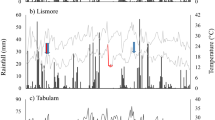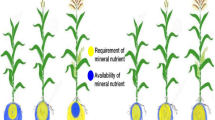Abstract
Guano is a natural organic fertilizer used in organic farming management when supplementary nitrogen is needed. In modern irrigated agriculture N top dressing is often applied through the irrigation water. The objective of this research was to evaluate the potential of guano as a source of available N when applied through water, compared with application to soil. The release of mineral and total soluble N from guano to water was monitored, as a function of time, under laboratory conditions, and compared with mineralization of guano in soils. The effect of guano:water ratio, aeration of the mixtures, addition of rock-phosphate or clay minerals, and temperature on the composition of the solutions was determined. Guano released more than 90% of its N content into solution during 10 d at a guano:water ratio of 1:10 at 27°C. The release of soluble N, of which 85% was NH4-N, was linked with an increase of pH from 7.0 to 8.5 or more. None of the treatments increased the rate or the total N release beyond that. Suboptimal temperatures, 13.6 ± 4.7°C or 50°C, greatly reduced the rate of guano-N release to solution. The mineralization of guano in soil was more rapid than in water, but the total N release was the same, leading to the conclusion that the application of guano through the irrigation water may be as efficient as directly to soil, provided sufficient time for fermentation is allowed.
Similar content being viewed by others
References
Anderson JPE (1982) Soil respiration. In: Page AL et al (eds) Methods of Soil Analysis, Agronomy 9, Part 2, 2nd edn, pp 831–871. Madison, WI: American Society of Agronomy
Cooke GW (1972) Fertilizing for Maximum Yield. Chapter 2, pp. 13–27. London; Crosby Lockwood & Son Ltd
Dewes T (1988) Chemical and microbial changes during the fermentation of liquid cattle manure treated with AGRIBEN and its ingredients. In: Agricultural Waste Management and Environment Protection. Proceedings of the 4th International CIEC Symposium (Braunschweig, FRG) Vol 1, pp 323–329. Gottingen, Germany. International Scientific Center of Fertilizers (CIEC)
Doran JW, Fraser DG, Culik MN and Liebhardt WC (1987) Influence of alternative and conventional agricultural management on soil microbial processes and nitrogen availability. Am J Alternative Agric 2: 99–106
Hadas A, Bar-Yosef B, Davidov S and Softer M (1983) Effect of pelleting, temperature and soil type on mineral nitrogen release from poultry and dairy manures. Soil Sci Soc Am J 47: 1129–1133
Levi M and Nitzani J (1986) [Compost]. Israel: Ministry of Agriculture, Extension Service, Dept of Garden Crops Bull pp 13 (in Hebrew)
Liebhardt WC, Andrews RW, Culik MN, Harwood RR, Janke RR, Radke JK and Rieger-Schwartz SL (1989) Crop production during conversion from conventional to low-input methods. Agron J 81: 150–159
Lockeretz W, Shearer G and Kohl DH (1981) Organic farming in the Corn Belt. Science 211: 540–547
Owen O, Rogers DW and Winsor GW (1950) The nitrogen status of soils. Part I. The nitrification of some nitrogeneous fertilizers. J. Agric Sci 40: 185–190
Author information
Authors and Affiliations
Additional information
Contribution from the ARO, The Volcani Center, Bet Dagan 50250, Israel, no. 3290-E, 1991 series.
Rights and permissions
About this article
Cite this article
Hadas, A., Rosenberg, R. Guano as a nitrogen source for fertigation in organic farming. Fertilizer Research 31, 209–214 (1992). https://doi.org/10.1007/BF01063294
Accepted:
Issue Date:
DOI: https://doi.org/10.1007/BF01063294




